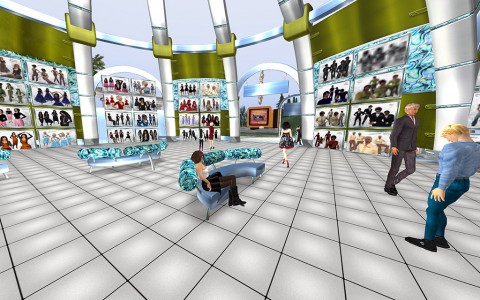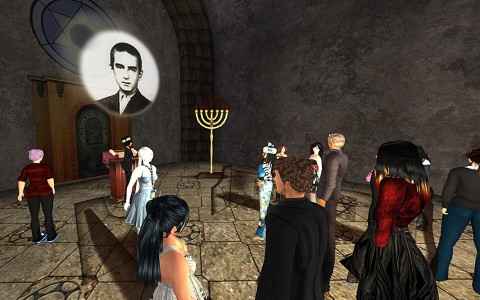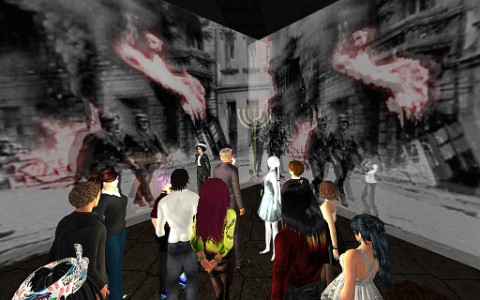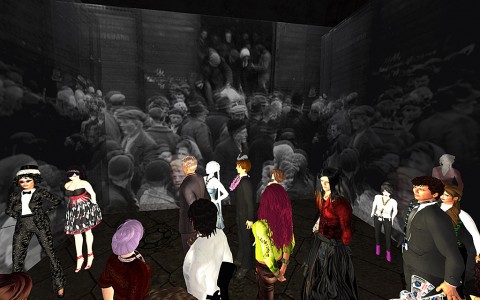As many of you will know the 2014 Virtual World Best Practices in Education conference was held from the 9th to the 12th of April and a very successful and well attended conference it was. A little harder for those outside the main time zone of PDT to get the full experience but nonetheless I managed to attend a number of excellent presentations. I also presented my own workshop on Creating Immersive Environments and I thought I would share some of that presentation, as a set of ideas, images, videos and SLurls, for those who may not have been able to attend.
Part of the challenge I set myself was to make use of some of the features and affordances of virtual worlds and move beyond a slideshow or lecture-based presentation. In that vein the workshop space was used as a form of holodeck to display representative aspects of the journey that I have taken over the past eight years in Second Life, designing and building educational virtual spaces, and provide a background for my narrative of that journey.
Creating Immersive Environments


The workshop began with a showing of the video from the SLENZ Midwifery build; part of the SLENZ Project from 2008-2009.
The workshop floor was then overlaid with the architect’s floor plan and part of the build was rezzed for the participants to explore.


Notes:
- Compromises in terms of realistic dimensions are often required by the need to cater for new users of the technology, e.g. the need for higher ceiling heights or wider corridors to cater for unskilled camera use.
- Role playing has a powerful part to play in vocational incentivising. The first year midwives who were to use the build only for information gathering, were often found going through the birth simulation in their own time. The nearest to being present to a birth that they would get in their first year but a motivating experience nonetheless.
SLurl for the full in-world Midwifery Build.
The workshop moved on to the next build in the SLENZ Project; the Foundation Studies build.
Again the floor was overlaid with the “design†for this build and the build was then rezzed on the workshop floor.



Notes:
- A build that emerged out of the space by beginning to build from ideas rather than a detailed plan; the benefit of building in a space like Second Life is the ability to design in situ on a 3D canvas. Created progressively from how it felt to be in the space.
- For the student body the sense of it having that hint of a game space added to the appeal of the build. They could interact with it in a playful manner regardless of facilitating staff being present.
- Upon reflection a missing factor was sound. In its interactions it is too quiet. This could also be said of the midwifery build.
SLurl for the full in-world Foundation Studies Build.
The next build presented was an aeromedical transfer simulation created for air-paramedic training. This was the first build I had enclosed in its own atmosphere so it was rezzed above the presentation platform and a set of teleporters provided.


Notes:
- Building realistic, representations of small, detailed models of medical equipment (pre-mesh), that worked accurately from a visual sense was really too time consuming to warrant doing. Upon reflection some form of HUD display along with static models in the simulation would have been more efficient.
- If the immediate space fulfils the purpose of the simulation it is not necessary to add detail to the peripheries.
- An enclosed, simulated environment (animated sky effect) with associated, relevant sound (plane engine noise) enhances the feel of a space and supports immersion.
At the end of this part of the workshop the participants teleported back down to the main platform. The following two videos were then presented to introduce the next phase of the presentation. These are short commentaries that formed part of my assessment portfolio for the MA Education in Virtual Worlds and demonstrate aspects of immersion, or the lack of them, that I believe deserve consideration when creating fully immersive environments.
The workshop then proceeded to demonstrate the transformation of a build from a static entity into a fully immersive environment through the gradual addition of layers of effects. Though each layer is simple in isolation, each adds a level of increasing complexity to the build that results in an environment that is, ultimately, experienced and not just seen.


As the still pictures don’t allow the reader to experience the effects I’ve added a short video that is a quick run-through of the demonstration.
The workshop finale had the participants experiencing the build that, for me, is the culmination of all the lessons learnt over my years of creating immersive educational spaces in virtual worlds. I have held this up for myself as something to aim for in terms of immersion, when developing any build since. A year on and one would think it would be too well-known, after the many hours spent creating, testing and demonstrating it, but even now experiencing it can leave me silently moved to tears.
As I stated to the participants at the end of the presentation, in terms of the other builds shown, although they have their merits as educational spaces, they are in some ways almost forgettable once they are de-rezzed. This build, Night, stays with me even when it has been removed from the scene. In my view this is immersion.
It uses many of the immersion affordances and features that I have considered in the presentation to this point, play notwithstanding; but the enclosed space environment, meaningful simplicity over confusing complexity, atmospheric effects and ambient sound all play their part.




As with the layering effects demonstration the images do not do this build justice. The following is the video I created to accompany my blog post on the Night build.
Footnote
In putting together the Creating Immersive Environments workshop for the VWBPE conference I have created it as a packaged up, take anywhere presentation. Should any group wish to avail themselves of it I would be quite happy to present it again, time and time zones permitting. It requires approximately 50 by 50 meters of bare space to set out the main platform, rez and run scripts permissions and a prim allowance of around 1,000 primitives at its maximum load. It takes approximately 90 minutes to get through.
(Article reprinted with permission from F/Xual Education Services.)
